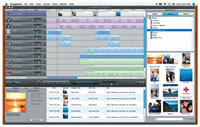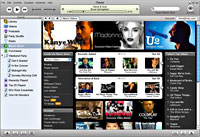 According to an online survey conducted by brand-meisters Brandchannel.com, Google has held on to its title as the world’s most influential brand in 2005, pushing Apple out of the numero uno spot for the second time this decade.
According to an online survey conducted by brand-meisters Brandchannel.com, Google has held on to its title as the world’s most influential brand in 2005, pushing Apple out of the numero uno spot for the second time this decade.
In the super-skinny frapuccinno-fuelled world of marketing and advertising, effective branding is the key to global recognition and soaring sales, and Brandchannel’s poll looks to big up the branding big boys.
Global top five brands Globally, top honours went to Google, who outflanked brand rivals Apple with an avalanche of punter-pleasing freebies like Google Mini, Desktop and Google Earth, described by Brandreport as, “arguably the greatest thing to hit the Internet since porn” (steady on, chaps!).
Globally, top honours went to Google, who outflanked brand rivals Apple with an avalanche of punter-pleasing freebies like Google Mini, Desktop and Google Earth, described by Brandreport as, “arguably the greatest thing to hit the Internet since porn” (steady on, chaps!).
Hot on their heels was Apple who notched up an impressive 2005, with the iPod shuffle, iPod nano, iPod video, Mac mini, and Tiger operating system rolling out over a busy year.
Joining the two technology heavyweights in the global top five were the newly arrived VoIP hotshots Skype, followed by Starbucks and Ikea.
Europe & Africa
In Europe and Africa, Nordic mobile technology kings Nokia reclaimed their number one slot, while Ikea stayed in second place for the fourth year in a row.
Once again, Skype rung up a new addition to the list, jumping sprightly into third place above Spanish clothing retailers Zara and car manufacturer BMW.
US & Canada Although Google whipped Apple globally, the company still rules the roost on their home turf, with Steve Jobs’ outfit being declared the leading brand in North America in front of their rivals.
Although Google whipped Apple globally, the company still rules the roost on their home turf, with Steve Jobs’ outfit being declared the leading brand in North America in front of their rivals.
The omnipresent coffee-shifters Starbucks brewed up a third place slot, while national retailer Target boxed up a well earned fourth place.
The cancer defying, uber-athlete Lance Armstrong pedalled his way into an unexpected fifth place, with the growing popularity of the classifieds site craigslist reflected by a sixth place listing above Coca Cola (8th) and Amazon.com (10th).
Asia Pacific
Sony continues to dominate the Asian Pacific market, hogging the number one position for the fourth time in just five years.
Toyota motor up to second place, while the ever ambitious Samsung find themselves slipping down to third place, above electronics giants LG (4th) and the multinational bank HSBC (5th).
Central & Latin America It’s a story of booze and beer in the central & Latin America segment, with Corona and Bacardi sitting proud in first and second places respectively.
It’s a story of booze and beer in the central & Latin America segment, with Corona and Bacardi sitting proud in first and second places respectively.
Movistar, the mobile phone operator owned by Telefónica, dials up a third place, with Rubber sandal maker Havaianas treading into fourth place above the Mexican cement manufacturer Cemex.
Over 2,500 people from 99 countries voted in the Brandchannel poll, with the company insisting that voters “should not be dismissed as a bunch of hyper-caffeinated gearheads”, claiming that their polls “identify brands that the mainstream world eventually catches up with.”
 Friday afternoon distractions.
Friday afternoon distractions. The expected has happened – Apple have unveiled their new Intel-basedMacs.
The expected has happened – Apple have unveiled their new Intel-basedMacs. Most of the keynote was about the new version on iLife, which you won’t be surprised to hear is called iLife’06. It continues to contain thestandard iTunes, iMovie HD, iDVD and GarageBand, but they’ve all had somemajor reworking.
Most of the keynote was about the new version on iLife, which you won’t be surprised to hear is called iLife’06. It continues to contain thestandard iTunes, iMovie HD, iDVD and GarageBand, but they’ve all had somemajor reworking. As
As  Happy New Year!!Since the New Year has just begun, a piece focusing on last year, the one that has just begun and the developments suspected to emerge during it seemed justified.
Happy New Year!!Since the New Year has just begun, a piece focusing on last year, the one that has just begun and the developments suspected to emerge during it seemed justified. You might wonder why I am so confident in this prediction: Afterall, Microsoft has been pushing out
You might wonder why I am so confident in this prediction: Afterall, Microsoft has been pushing out  There were of course
There were of course  However, this has always been on quite specific Mac-related Websites, and not in main stream media.
However, this has always been on quite specific Mac-related Websites, and not in main stream media. Motorola says adieu to Apple and bonjour to Linux as it unveiled its shiny new ROKR E2 phone at the Consumer Electronics Show today.
Motorola says adieu to Apple and bonjour to Linux as it unveiled its shiny new ROKR E2 phone at the Consumer Electronics Show today. Running on a new Linux-based operating system, the Motorola ROKR E2 also includes a high-res 320×240 screen, a 1.3 megapixel camera with video recording, a built-in FM radio, Opera Web browser Bluetooth (supporting wireless music streaming to stereo Bluetooth headphones), and joy-of-joys – a standard 3.5mm stereo headphone jack and not one of those ruddy annoying mini sockets that are incompatible with normal headphones.
Running on a new Linux-based operating system, the Motorola ROKR E2 also includes a high-res 320×240 screen, a 1.3 megapixel camera with video recording, a built-in FM radio, Opera Web browser Bluetooth (supporting wireless music streaming to stereo Bluetooth headphones), and joy-of-joys – a standard 3.5mm stereo headphone jack and not one of those ruddy annoying mini sockets that are incompatible with normal headphones. In the absence of iTunes, Motorola intends to push their iRadio Music Service, a subscription music service that uses mobile handsets as the base platform.
In the absence of iTunes, Motorola intends to push their iRadio Music Service, a subscription music service that uses mobile handsets as the base platform. Creative Zen Vision:M
Creative Zen Vision:M The player’s a versatile chap too, with the Vision:M outgunning the iPod by supporting a wider range of formats, like MP3, WMA and PlaysForSure audio formats and MPEG1/2/4, DivX and XviD, Motion JPEG and WMV for video.
The player’s a versatile chap too, with the Vision:M outgunning the iPod by supporting a wider range of formats, like MP3, WMA and PlaysForSure audio formats and MPEG1/2/4, DivX and XviD, Motion JPEG and WMV for video. Sony NW-A1000
Sony NW-A1000 The palm sized player (88 x 55 x 19 mm) comes with a built in 6GB hard drive and supports MP3 files as well as Sony’s ATRAC3 and ATRAC3+ audio formats. Battery life is claimed at 20 hours (although several reviews have found that figure to be wildly optimistic).
The palm sized player (88 x 55 x 19 mm) comes with a built in 6GB hard drive and supports MP3 files as well as Sony’s ATRAC3 and ATRAC3+ audio formats. Battery life is claimed at 20 hours (although several reviews have found that figure to be wildly optimistic). Apple iPod Nano
Apple iPod Nano This book covers the Mac OS X 10.4 (aka Tiger) for geeks who have come from a Unix/Linux environment and are happiest using the command line, not sexy GUIs (graphical user environments).
This book covers the Mac OS X 10.4 (aka Tiger) for geeks who have come from a Unix/Linux environment and are happiest using the command line, not sexy GUIs (graphical user environments). Bits like the section of PearPC might be a bit over the top for even a normal Unix user, but it does work. If you just want to develop Mac OS programs, this could be a way to do it – although it will be slowly as the emulator isn’t very fastest.
Bits like the section of PearPC might be a bit over the top for even a normal Unix user, but it does work. If you just want to develop Mac OS programs, this could be a way to do it – although it will be slowly as the emulator isn’t very fastest. NBC Universal and Apple have struck a deal to make NBC-owned television shows, such as “The Office” and “Law & Order,” available on the iTunes music store.
NBC Universal and Apple have struck a deal to make NBC-owned television shows, such as “The Office” and “Law & Order,” available on the iTunes music store. The shows will be available from next week, downloadable from the iTunes Music Store the day after they air for $1.99 (£1.15, €1.70) per episode
The shows will be available from next week, downloadable from the iTunes Music Store the day after they air for $1.99 (£1.15, €1.70) per episode